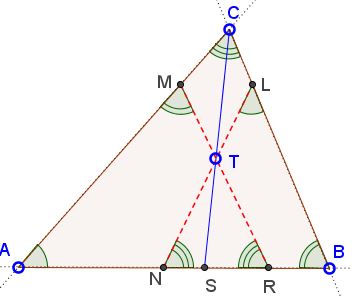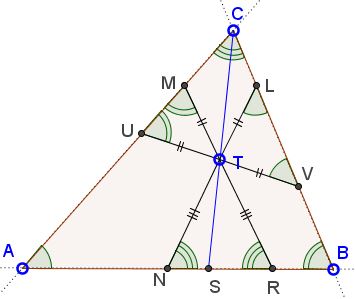Symmedian and 2 Antiparallels
What is this about?
A Mathematical Droodle
|Activities| |Contact| |Front page| |Contents| |Geometry|
Copyright © 1996-2018 Alexander BogomolnyThe applets illustrates the following statement:
In a triangle ABC the antiparallels to sides AB and AC that meet on the symmedian from C have equal lengths.

Let CS be the symmedian and MR and LN the two antiparallels in question that meet in point T on CS. Triangle RTN having equal base angles at R and N is isosceles. Therefore,
| (1) | TN = TR. |
Draw the third antiparallel UV through T.

Similarly to the above, we have
TL = TV and
TM = TU.
However, as we know,
TU = TV.
Therefore
| MR | = TM + TR |
| = TL + TN | |
| = LN. |
Note that we actually got a little more than claimed: the corresponding pieces of the equal antiparallels cut off by the symmedian are also equal.
By transitivity, the three antiparallels through the symmedian point all have equal lengths.
Symmedian
- All about Symmedians
- Symmedian and Antiparallel
- Symmedian and 2 Antiparallels
- Symmedian in a Right Triangle
- Nobbs' Points and Gergonne Line
- Three Tangents Theorem
- A Tangent in Concurrency
- Symmedian and the Tangents
- Ceva's Theorem
- Bride's Chair
- Star of David
- Concyclic Circumcenters: A Dynamic View
- Concyclic Circumcenters: A Sequel
- Steiner's Ratio Theorem
- Symmedian via Squares and a Circle
- Symmedian via Parallel Transversal and Two Circles
- Symmedian and the Simson
- Characterization of the Symmedian Point with Medians and Orthic Triangle
- A Special Triangle with a Line Through the Lemoine Point
|Activities| |Contact| |Front page| |Contents| |Geometry|
Copyright © 1996-2018 Alexander Bogomolny73459462
